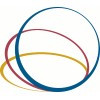Effect of Biofeedback Training on Accommodation During Multifocal Lens Wear in Young Adults
Accomodation

About this trial
This is an interventional treatment trial for Accomodation
Eligibility Criteria
Inclusion Criteria: Best corrected monocular Snellen visual acuity (VA) ≧ 20/25 Age 18 to 30 years Refractive error spherical equivalent between -0.75 D and -10 D Astigmatism ≤ 0.75 D Age-appropriate amplitude of accommodation No suspected or confirmed eye disease (anamnesis) No accommodative or binocular function abnormalities Agreement to participate in the study (informed consent of subjects) Exclusion Criteria: Persons who are incapable of giving consent Refractive error spherical equivalent < -10 D and > -0.75 D Astigmatism > 0.75 D Abnormal binocular functions Medication affecting accommodative response or causing dry eye
Sites / Locations
- State University of New York, College of OptometryRecruiting
Arms of the Study
Arm 1
Arm 2
Arm 3
Experimental
Experimental
Experimental
The time course group
The repetition group
The longer duration group
The time course of the effect of biofeedback training in young adults wearing MFCLs. Subjects will receive one episode of auditory biofeedback training and accommodation will be measured before the training and after the training on a weekly basis for 3 weeks.
Subjects will receive one episode of auditory biofeedback training every week for 3 weeks and accommodation will be measured before the training and after the training on a weekly basis.
Subjects will receive one episode of auditory biofeedback training for twice as long every week for 3 weeks and accommodation will be measured before the training and after the training on a weekly basis.
Outcomes
Primary Outcome Measures
Secondary Outcome Measures
Full Information
1. Study Identification
2. Study Status
3. Sponsor/Collaborators
4. Oversight
5. Study Description
6. Conditions and Keywords
7. Study Design
8. Arms, Groups, and Interventions
10. Eligibility
12. IPD Sharing Statement
Learn more about this trial
